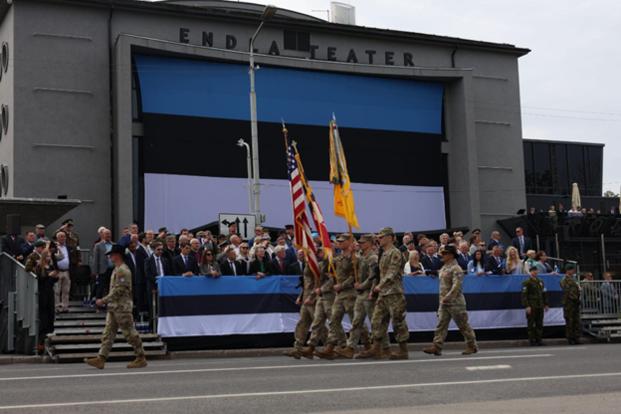Three Russian MiG-31 fighters entered Estonian airspace Friday morning and stayed for 12 minutes before Finnish, Italian, and Swedish jets escorted them out. The Kremlin denied the accusation and insisted that the jets remained in neutral air. A NATO spokesperson called the incident “yet another example of reckless Russian behavior and NATO’s ability to respond.”
The breach came a week after Russian drones crossed into Polish and Romanian airspace, where they were shot down. Russia frequently tests NATO defenses, but allies say the latest incidents show a troubling escalation.
President Donald Trump told reporters Friday, “I don’t love it. I don’t like when that happens. Could be big trouble.” His remarks followed the administration’s announcement that it plans to cut security funding for Estonia, Latvia, and Lithuania, the three Baltic members of NATO.
NATO’s Baltic Frontline
Estonia, Latvia, and Lithuania are small but strategically vital NATO allies. They were invaded and occupied by the Soviet Union during World War II, regained independence in the early 1990s, and joined NATO in 2004. They host rotating American and allied troops for training and cooperation missions each year.
Sharing a border with Russia and Belarus, the Baltic nations are frequently targeted by Russian provocations. Estonian Prime Minister Kristen Michal said, “NATO’s response to any provocation must be united and strong.”
At a United Nations Security Council emergency meeting, NATO representatives denounced Moscow’s actions and denials as dangerous. UK foreign secretary Yvette Cooper said: “If we need to confront planes operating in NATO airspace without permission, we will.” Russian first deputy representative Dmitry Polyanskiy accused NATO representatives of Russophobia and spreading lies.
NATO’s Weakest Point
Along the Poland-Lithuania border, the 40-mile Suwalki Gap is NATO’s only land corridor to the Baltics, wedged between Belarus and Russia’s Kaliningrad enclave. In a conflict, Russia could try to close the gap and sever the land route, isolating the Baltic states.
If cut off, NATO would have to reinforce by sea, exposing ships to Russian anti-ship missiles and leaving troops already in the Baltics at risk of encirclement.

Russia’s Recent Behavior
The breach of Estonia’s airspace is part of a broader campaign to test NATO responses. Days earlier, Russian drones entered Polish and Romanian airspace and were shot down. Czech Republic President Petr Pavel has suggested NATO consider stronger responses, including downing jets.
In 2015, NATO member Turkey shot down a Russian jet along the Syrian border, killing one pilot. A subsequent Russian rescue mission lost a helicopter and a marine, triggering a major crisis between Moscow and the alliance.
According to the BBC, Estonia has invoked Article 4 of the alliance’s treaty, requiring a meeting of all 32 members to discuss the provocation. It is the second time this month, following Poland’s request on the 10th. The meeting is scheduled for Tuesday morning.
The Trump administration recently announced plans to cut security funding to NATO, specifically the Baltic states. U.S. presence in the region deters Moscow and reassures allies; without it, NATO’s deterrence could falter in its most vulnerable corner.
Ironically, the Baltic nations are among the allies that meet — and often exceed — defense spending goals, especially since Russia’s invasion of Ukraine. According to Reuters, the U.S. government plans to cut $200 million a year in defense support for the Baltics. Representatives from the three nations have urged Congress to maintain American security investments.
Nevertheless, US Ambassador to the UN, Mike Waltz, stated: “The United States and our allies will defend every inch of NATO territory. Russia must urgently stop such dangerous behaviour.” Weakening support to the Baltics doesn’t just risk small countries on NATO’s edge — it risks the credibility and security of NATO itself.
Story Continues
Read the full article here



